Better rules for major project reviews

To protect canada’s environment and grow the economy
Overview
What we are doing
Handbook
A clean environment and a strong economy go hand in hand. In the Speech from the Throne, the Government of Canada promised to review environmental and regulatory processes to rebuild public trust.
The government put in place interim principles for project reviews in January 2016, then launched a comprehensive process in June 2016 to review existing laws and seek Canadians’ input on how to improve environmental and regulatory processes.
These aimed to address concerns about previous reforms to environmental assessments, lost protections for our fisheries and waterways, and the need to modernize the National Energy Board.
The government has delivered on its promise by proposing better rules for environmental and regulatory processes. This milestone was informed by over 14 months of public, stakeholder and Indigenous consultations, Expert Panel reports and Parliamentary studies.
A clean environment and a strong economy go hand in hand.
The proposed new legislation reflects values that are important to Canadians — including early, inclusive and meaningful public engagement; partnerships with Indigenous peoples; timely decisions based on the best available science and Indigenous knowledge; and sustainability for present and future generations.
The environment and economy go together. If adopted, the new legislation would restore confidence that good projects can move forward in a responsible, timely and transparent way that protects the environment, creates jobs and builds a strong economy.
Why we are doing it
Canada is blessed with abundant natural riches. Developed wisely, major resource projects can power economies, support communities, and create jobs. Developed without proper oversight, they can lead to environmental degradation, stranded assets, broken trust, and lost opportunities.
With hundreds of major resource projects – worth over $500 billion in investment planned over the next 10 years in Canada, better rules are essential.
Canadians want to know that they can count on the Government’s assessment process to ensure that sustainable, beneficial, and environmentally responsible projects go ahead. Companies also need clear timelines and better information about what’s expected of them.With better rules for major projects, we would be able to grow our economy and build a strong middle-class while protecting our environment and ensuring healthy communities.
Improvements needed to the current system:
- More transparency and certainty that decisions would be based on robust science, evidence and Indigenous knowledge
- More and earlier opportunities for meaningful participation by Indigenous peoples and Canadians
- More Indigenous leadership of and partnership in project review
- Impact assessment must look at all of a project’s impacts to foster sustainability, including environmental, health, social and economic impacts
- More coordination with provinces to reduce red tape and avoid duplication
- More predictable and consistent timelines
If adopted, these better rules would mean good projects would move forward in a predictable, timely way that respects Indigenous peoples and protects our environment.
What it will improve
Project reviews should be rigorous -- but they should also be timely. The process would be more efficient. Projects would go through an early planning and engagement phase where project impacts and issues would be discussed with the public and Indigenous groups early on. This would lead to better project design and greater clarity for companies by identifying what is expected of them at the outset. We would also coordinate with provinces to reduce red tape for companies and avoid duplicating efforts. A clearer, more predictable process would mean federal project decisions are more timely.
We have built on what is working in the current system and have put in place modern measures to:
- Protect the environment;
- Regain public trust;
- Strengthen our economy; and
- Support reconciliation with Indigenous peoples.
Assessing what matters
In our consultations with Canadians, we also heard that federal project reviews should look at more than just environmental impacts; that assessments should foster sustainability in Canada. Going forward, we would expand project reviews to assess what matters to Canadians. The new impact assessment approach would assess a project’s potential environmental, health, economic, and social impacts. We would also require a gender-based analysis for every review. This provides a more holistic picture of a project’s impacts on communities to better inform decision-making.
What is a gender-based analysis plus (GBA+)?
GBA+ is an analytical tool used to assess how diverse groups of women, men and gender-diverse people may experience policies, programs and initiatives. The “plus” in GBA+ acknowledges that GBA goes beyond biological (sex) and socio-cultural (gender) differences.
For example, a GBA+ analysis would study how the influx of male workers in a remote work camp could affect women living in nearby communities.
An impact assessment approach would help advance Canada’s commitments for clean growth and support our transition to a low-carbon economy.
If adopted, these better rules would lead to more predictable and timely project reviews, more trustworthy decisions, and more responsible development of Canada’s natural resources. This would position us to remain globally competitive, attract investment, develop natural resources responsibly and advance a clean growth economy.
1. The proposed new system
A more efficient and predictable process. More timely decision-making.
The key changes proposed to the environmental and regulatory system include: shifting from environmental to impact assessment and improving the process; the goal of one project, one review through coordination with provinces; establishing a single agency responsible for assessments; updating the project list based on clear criteria; adding a new early planning and engagement phase; creating a more predictable and timely process; project decisions based on robust science and evidence, and the public interest; and continuous tracking of results.
Legislated timelines are maintained but reduced from 365 to a maximum of 300 days for assessments led by the Agency. More complex projects or projects involving a life-cycle regulator would be assessed by a panel, and efficiencies gained through early planning and engagement will enable us to reduce the timeline from 720 days to 300 days, up to a maximum of 600 days.
For projects assessed by the Agency, the Minister would have 30 days to make the public interest decision or refer the decision to the Cabinet. For projects assessed by a review panel, the Cabinet would have 90 days to make the public interest decision to determine whether the project may proceed. The Minister would have the authority to approve exceptions to the timeline under certain circumstances (e.g. to align timelines with other jurisdictions during cooperative assessments).
Diagram: The proposed new system at a glance
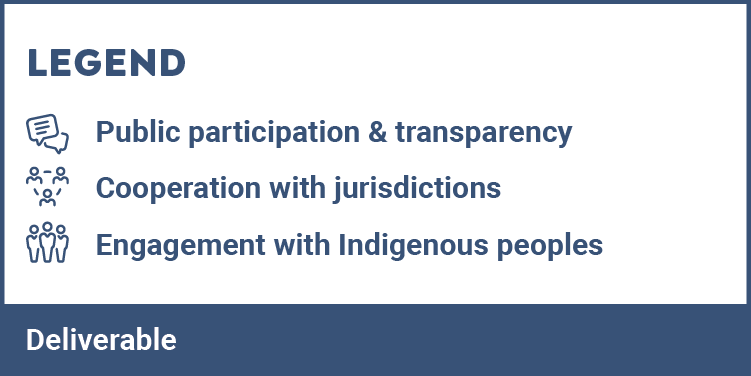
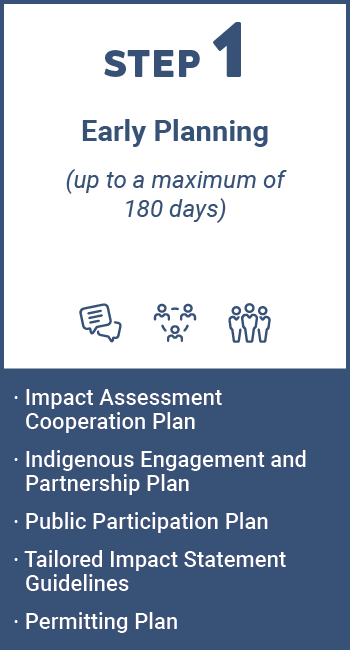
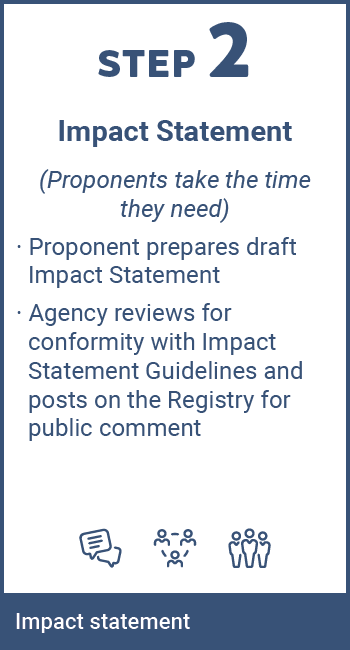


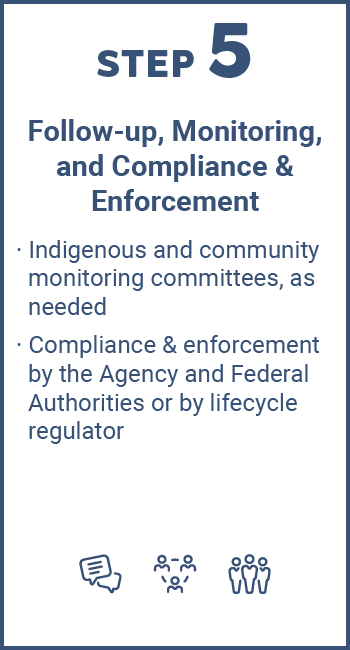
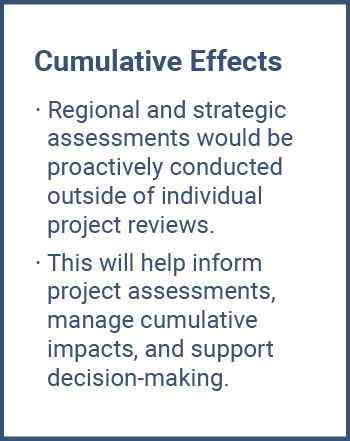
Long description
Step 1: Early Planning
(up to a maximum of 180 days)
Includes public participation and transparency, cooperation with jurisdictions, and engagement with Indigenous peoples.
Deliverables:
- Impact Assessment Cooperation Plan
- Indigenous Engagement and Partnership Plan
- Public Participation Plan
- Tailored Impact Statement Guidelines
- Permitting Plan
Step 2: Impact Statement
(Proponents take the time they need)
Includes public participation and transparency, cooperation with jurisdictions, and engagement with Indigenous peoples.
Deliverable: Impact Statement
Proponent prepares draft Impact Statement.
Agency reviews for conformity with Impact Statement Guidelines and posts on the Registry for public comment.
Step 3: Impact Assessment
Includes public participation and transparency, cooperation with jurisdictions, and engagement with Indigenous peoples.
Deliverable: Assessment Report
Led by the Agency
(up to a maximum of 300 days)
Agency assesses Impact Statement and prepares Impact Assessment Report.
OR
Led by Review Panel
(up to a maximum of 600 days)
Assessment by Review Panel or Joint Review Panel.
OR
Led by an Integrated Review with lifecycle regulators
(300 days, up to a maximum of 600 days)
May be conducted jointly with other jurisdictions.
Step 4: Decision-Making
Deliverable: Decision Statement with detailed reasons
Decision
(up to a maximum of 30 days)
Minister of Environment and Climate Change Canada determines public interest.
OR
Decision
(up to a maximum of 90 days)
Cabinet determines public interest.
Step 5: Follow-up, Monitoring, and Compliance and Enforcement
Includes public participation and transparency, cooperation with jurisdictions, and engagement with Indigenous peoples.
Indigenous and community monitoring committees, as needed.
Compliance and enforcement by Agency and Federal Authorities or by life-cycle regulator.
Note: Regional and strategic assessments would be proactively conducted outside of individual project reviews. This will help inform project assessments, manage cumulative impacts, and support decision-making.
What is the difference between a designated and non-designated project?
Major projects that have potential for significant adverse environmental effects in areas of federal jurisdiction are called designated projects and require federal review.
A non-designated project is one that does not require a federal impact assessment such as dock buildings or culvert replacements.
Who would conduct impact assessments?
- A single federal Agency would lead all impact assessments for major projects (whereas there were three previously working under different processes).
- The Canadian Environmental Assessment Agency would become the Impact Assessment Agency of Canada and be responsible for leading all assessments and coordinating Crown consultations for all federally designated projects.
- This builds trust, reduces confusion and ensures the approach is consistent.
- The Agency would draw on the expertise of other bodies like the Canadian Energy Regulator, Canadian Nuclear Safety Commission and offshore boards.
- The Minister of Environment and Climate Change would appoint a review panel to assess designated energy, transmission and offshore projects, and would integrate the expertise of these life-cycle regulators.
What projects are assessed?
- The project list would be updated, in consultation with stakeholders. The focus would be on projects that pose significant risks to the environment in areas of federal jurisdiction. This would be defined by regulation, which would be developed in parallel with the legislative process.
What is the project list?
The project list identifies projects that have potential to pose significant risks to the areas of the environment that fall under federal jurisdiction.
The Minister of Environment and Climate Change would continue to have authority to designate non-designated projects that could have adverse impacts on areas of federal jurisdiction, based on clear criteria and a more transparent process.
What happens to projects that are not designated & how would the environment be protected?
- The new changes would mean better coordination and alignment with other federal departments, including those that issue permits and life-cycle regulators.
- Non-designated projects would continue to be reviewed under other federal regulatory legislation, when applicable.
- We are proposing other measures that would enhance environmental protection regardless of project size. For example, the Fisheries Act would require codes of practice for the management of impacts on fish and fish habitat, and updated regulatory authorities for ecologically significant areas.
What is a life-cycle regulator?
A life-cycle regulator such as the Canadian Nuclear Safety Commission, the National Energy Board or offshore boards, oversees the complete life-cycle of a project.
What continues?
- Life-cycle regulators would remain responsible for regulating projects and assessing non-designated projects.
- Life-cycle regulators would work collaboratively with the Agency to provide expertise, as needed.
Key features:
- Proactive strategic and regional assessments would evaluate big-picture issues (e.g. climate change, biodiversity, species at risk), the cumulative effects of development and provide context for impact assessments.
- An early planning and engagement phase for all projects would build trust, increase efficiency, improve project design, and give companies certainty about the next steps in the review process.
- Indigenous engagement and partnership throughout the process.
- Increased public participation opportunities.
- Legislated timelines to provide clarity and regulatory certainty.
- The legislated timeline for Agency led impact assessments would be reduced from 365 to a maximum of 300 days. More complex projects or projects involving a life-cycle regulator would be assessed by a panel, and efficiencies gained through early planning and engagement will enable us to reduce the timeline from 720 days to 300 days, up to a maximum of 600 days. A more timely process would lead to more timely decisions.
- Monitoring, follow-up, enforcement and permitting:
- Life-cycle regulators and permitting departments would work collaboratively with communities and Indigenous peoples to enhance monitoring, follow-up, and compliance.
Figure 2 – Results of early planning and engagement

Companies
- Timelines, expectations and requirements are clarified up front, ensuring that proponents know what is expected of them
- Early identification and engagement with potentially impacted Indigenous groups, regulators, departments, stakeholders, and the public
- The project design benefits from community input
- Goal of one project, one assessment, and coordination early on with other jurisdictions to reduce red tape and duplication

Environmental Protection
- Potential environmental impacts identifed early on
- Science and data scoped early with points of external review
- Project design is adapted early to identify issues related to the environment
- Assess project’s contribution to Canada’s climate commitments
- Requirement to consider best available technologies
- Federal and independent reviews of science

Indigenous
- Early and ongoing engagement
- Impacted Indigenous groups are identifed
- Aiming to secure consent
- Funding available
- Consultation planning with government and proponent
- Consultation protocols developed
- Comment opportunity on project plan
- Working together in partnership from the start
- Input into tailored Impact Statement Guidelines
- Mandatory consideration of Indigenous knowledge

Canadians
- Public can participate in project reviews early on
- Identify issues to help shape the project design
- Provide input into the project plan
- Process is transparent and designed to encourage participation
- Restored trust in how decisions are made
An impact assessment approach would provide a more holistic view of a project’s potential impacts on our environment, our economy, Indigenous peoples’ rights, and more.
2. Impact Assessments: Sustainability and the Public Interest
If adopted, what are the key changes to how projects would be assessed?
More holistic assessments
- A move from environmental assessments to impact assessments based on the principles of sustainability.
- Assessments would consider a whole range of potential impacts to understand how a proposed project could affect not just our environment but also health, social and economic issues over the long term.
- Assessments would also consider whether companies are using the best available technologies and practices to reduce effects on the environment.
- There would be two types of assessments: assessments by the Agency and assessments by a review panel, which can be tailored to meet the specific needs for any project.
- Consistent use of gender-based analysis plus (GBA+) in assessments.
- The legislation requires an assessment of the impacts of a project on Indigenous peoples and their rights.
- Assessments must consider both the positive and negative impacts of a project.
- Climate change considerations would be systematically integrated throughout the assessment process. As a first step, Environment and Climate Change Canada would conduct a strategic assessment of climate change, which would be completed to provide direction to ensure Canada’s action on climate change is reinforced through the impact assessment process.
Decision-making
- Decisions would be based on whether a project with adverse effects within federal jurisdiction are in the public interest. Public interest determination would be guided by:
- Project’s contribution to sustainability
- Extent to which these effects are adverse
- Measures to mitigate adverse effects
- Impacts on Indigenous groups and on their rights
- Impact on Canada’s ability to meet its environmental obligations and climate change commitments.
Federal lands
- Federal authorities would be required to conduct environmental assessments for all “non-designated” projects on federal lands, to manage environmental effects. Additional improvement include new requirements for notifying the public, conducting a 30 day public comment period, transparently sharing information and a legislated list of factors to guide the assessments.
3. DECISIONS BASED on Robust Science, Evidence, and Indigenous Knowledge:
To ensure that projects start with the best available science and evidence, we would be proactive in studying and providing information on the state of the environment across Canada.
We would make sure decisions on projects are guided by robust science, evidence and Indigenous knowledge.
Government scientists would review any studies provided by companies, and independent scientific reviews would be done when there is strong public concern, or the results of a study are uncertain.
We would make science available to all Canadians, not just the experts, by providing plain-language summaries of the facts that support assessments. Greater transparency can lead to better projects.
How would Indigenous knowledge be incorporated and protected?
Indigenous knowledge arises from and is inextricably linked to the land. It is an important knowledge stream and source of evidence in impact assessment and regulatory processes. It strengthens the rigour of our assessments and improves decision making.
It would be mandatory to consider and protect Indigenous knowledge, if provided, alongside other sources of evidence.
- We would co-develop tools, guidance, and capacity with Indigenous peoples to better support and systematically consider Indigenous knowledge.
- We would protect the confidentiality of Indigenous knowledge (e.g. sacred site locations) and respect Indigenous laws and protocols for its use.
These changes would increase access to science and evidence, and make easy-to-understand summaries of decisions publicly available.
What other measures would ensure science integrity?
- We would increase public access to science and evidence and make easy-to-understand summaries of decisions publicly available. The federal government’s Chief Science Advisor would review the methods and integrity of the science used in making decisions.
- We would make federal science open by default and available online. We would create an Open Science and Data Platform that would provide a user-friendly interface for accessing data related to cumulative impacts, impact assessments, strategic assessments and regulatory processes.
- A technical advisory committee on science and knowledge would be established to provide expert advice to the Impact Assessment Agency of Canada on issues such as research priorities and technical guidance documents.
How would cumulative effects on the environment be addressed?
Cumulative effects are the changes to the environment caused by a variety of activities over time.
By better enabling robust science, evidence and Indigenous knowledge and technology, and collaboration with provinces and territories, Indigenous people and stakeholders, we would better understand the state of the environment regionally and nationally, including the cumulative effects of development.
This would help us understand the “big picture” so we can consider impacts of development in the early planning stages and make science-based to guide the path forward.
Regional assessments would be undertaken to guide planning and management of cumulative effects, identify the potential impacts on the rights of Indigenous peoples, and inform project assessments.
Strategic assessments would be conducted to explain the application of environmental frameworks to activities subject to federal oversight and regulation.
- In support of our commitments to clear growth and in support of our transition to a low-carbon economy, we would be launching a strategic assessment for climate change.
- The Minister of Environment and Climate Change would have the authority to establish committees to conduct regional or strategic assessments.
4. More openness, transparency and public participation:
What would be different if the new rules are adopted?
- A modern, user-focused, public registry would be developed as a one-stop shop for information related to projects and the impact assessment process and other relevant regulatory/permitting processes. The new Impact Assessment Registry would include much more information on projects, supporting information, the process and decisions.
- Increased project information would be proactively posted online.
- Participant funding programs would be enhanced to support the participation of the public and Indigenous peoples. This includes expanding eligible activities, increasing funding levels, and enhancing the process to reduce administrative delays.
- Creating opportunities for Indigenous partnerships and collaboratively developing monitoring programs.
- Greater use of plain-language and accessible information, including scientific evidence.
- Reasons for decisions would be made publicly available.
- Improved online and interactive tools to engage Canadians.
- Increased use of a variety of engagement techniques to encourage local participation and seek a full-range of views.
- Information collected would inform decision-making on projects.
Who can participate?
All Canadians can have a say and participate in project assessments.
- There would be no requirement for individuals to meet specific criteria to participate as part of the assessment process (no more “standing test” or “interested party” requirements).
- There would be opportunities for timely and meaningful engagement throughout the process.
By recognizing Indigenous rights and knowledge in project reviews, and working in partnership from the start, we would advance Canada’s commitment to reconciliation, and get to better project decisions.
5. Building new partnerships with Indigenous peoples:
Reconciliation must guide partnerships with Indigenous peoples, recognizing and respecting rights and interests, their deep connection to their lands, territories and resources, and their desire to participate as partners in the economic development of their territories. We recognize that reconciliation requires sustained government-wide action and needs to be at the centre of all aspects of our relationship.
How would we further our objective of reconciliation if the new rules are adopted?
- A single Agency to coordinate Crown consultations for all federally designated projects, including those involving lifecycle regulators, to support long-term relationship building and Indigenous participation.
- Early and inclusive opportunities for engagement and participation at every stage, in accordance with a co-developed engagement plan, with the aim of securing free, prior and informed consent through processes based on mutual respect and dialogue.
- Legislative requirement to consider potential impacts on Indigenous rights and culture in assessments and in decision-making on projects.
- Mandatory consideration of Indigenous knowledge alongside science and other evidence.
- Indigenous governing bodies would have greater opportunities to exercise powers and duties under the Act.
- Assessments conducted by Indigenous governing bodies are considered as part of federal assessments.
- New legislative provisions to provide for greater Indigenous expertise on assessment boards and review panels.
- Creating opportunities for Indigenous partnerships and co-development in monitoring.
- Collaboration on regional assessments and required consideration of Indigenous knowledge.
- Expanded and streamlined participant funding to support Indigenous participation and capacity development.
- An Indigenous Advisory Committee would be established to work with the Agency on policy and technical guidance on issues of concern to Indigenous peoples.
6. Increased Cooperation with provinces:
When we work together, we learn from each other. The new system will respect the jurisdiction of provinces.
What would be different if the new rules are adopted?
- “One project, one assessment” is a guiding principle to more timely project assessments for companies and avoid duplicating efforts in reviewing proposed projects.
- Any jurisdiction — provinces or Indigenous governing bodies — can request to have their assessment process substitute for that of the federal government. However for substitution to be granted the jurisdictions process must meet or exceed federal standards in areas such as the breadth of the assessment, public participation, Indigenous consultation and transparency.
- Substitution allows the federal government to rely on another jurisdiction’s assessment process to provide the information needed to support the federal government in taking their decision related to a project.
- Working with provinces, territories and Indigenous peoples to guide planning and management of cumulative effects.
Next Steps
The Government of Canada’s proposed legislation, if adopted, would put in place better rules to:
- Protect the environment;
- Regain public trust;
- Strengthen our economy; and
- Support reconciliation with Indigenous peoples.
The new rules proposed today must still be passed by Parliament. Until the new rules come into effect, existing laws and interim principles for project reviews would continue to apply to projects under review. The government would seek input from Canadians on regulations and policy changes required to accompany the legislation.
Visit canada.ca/environmentalreviews for more information.